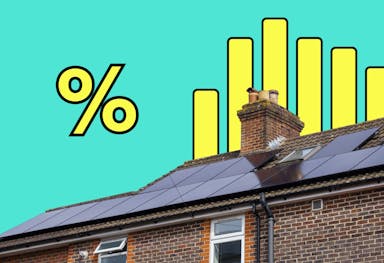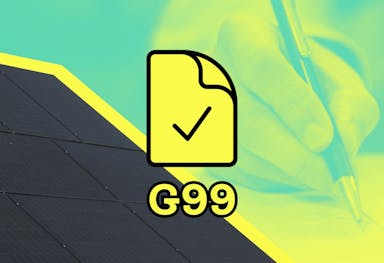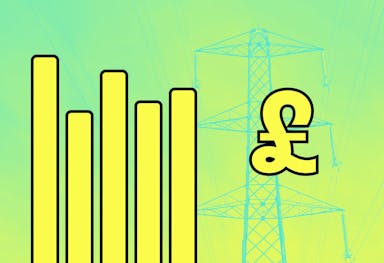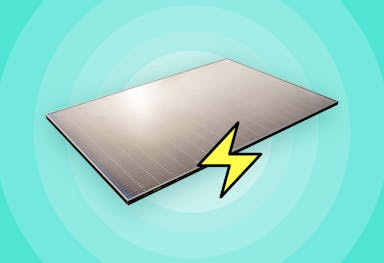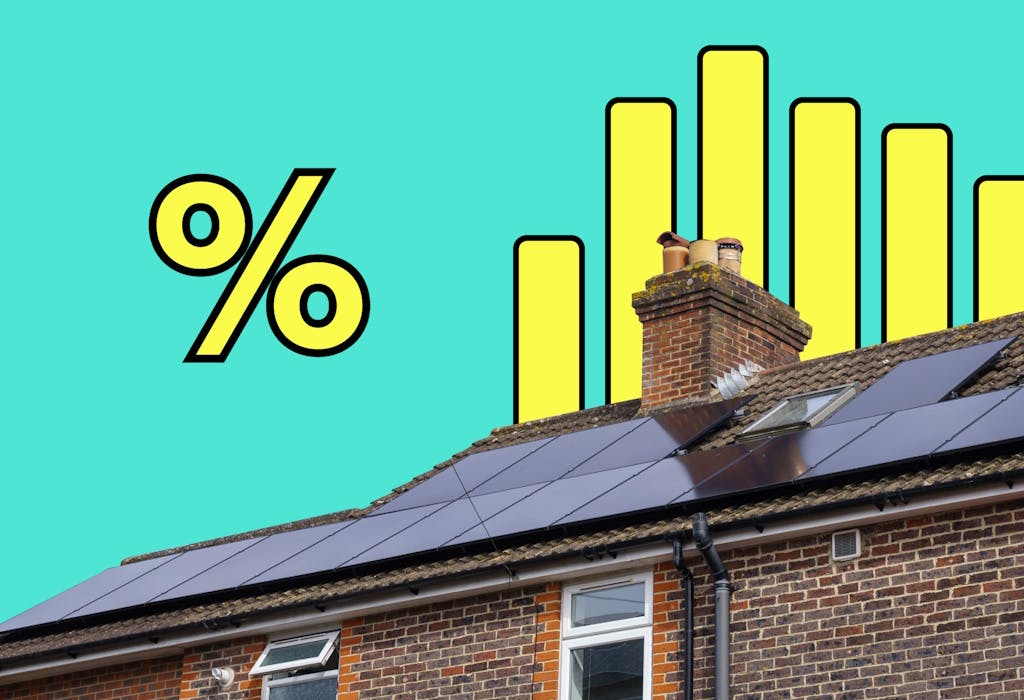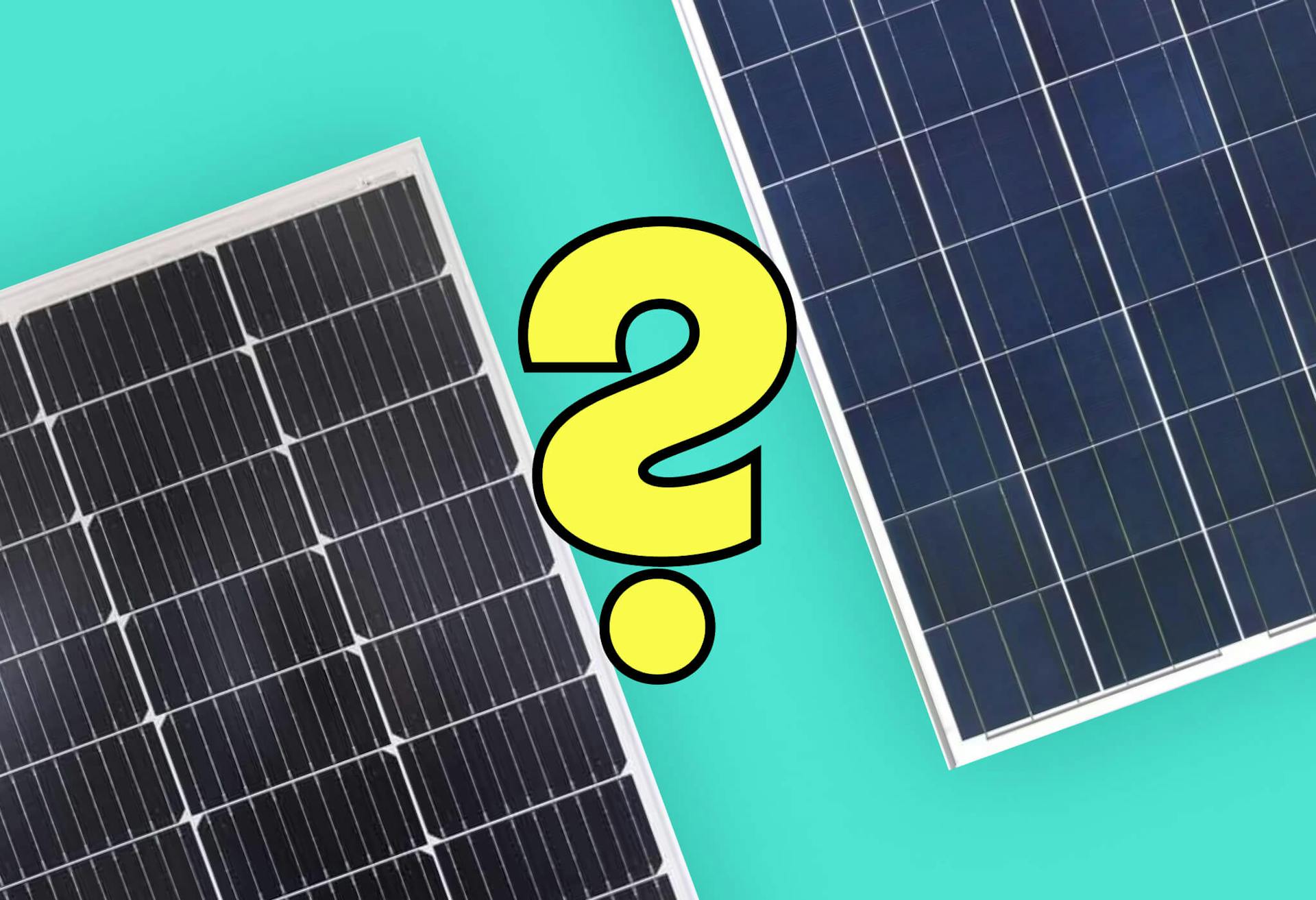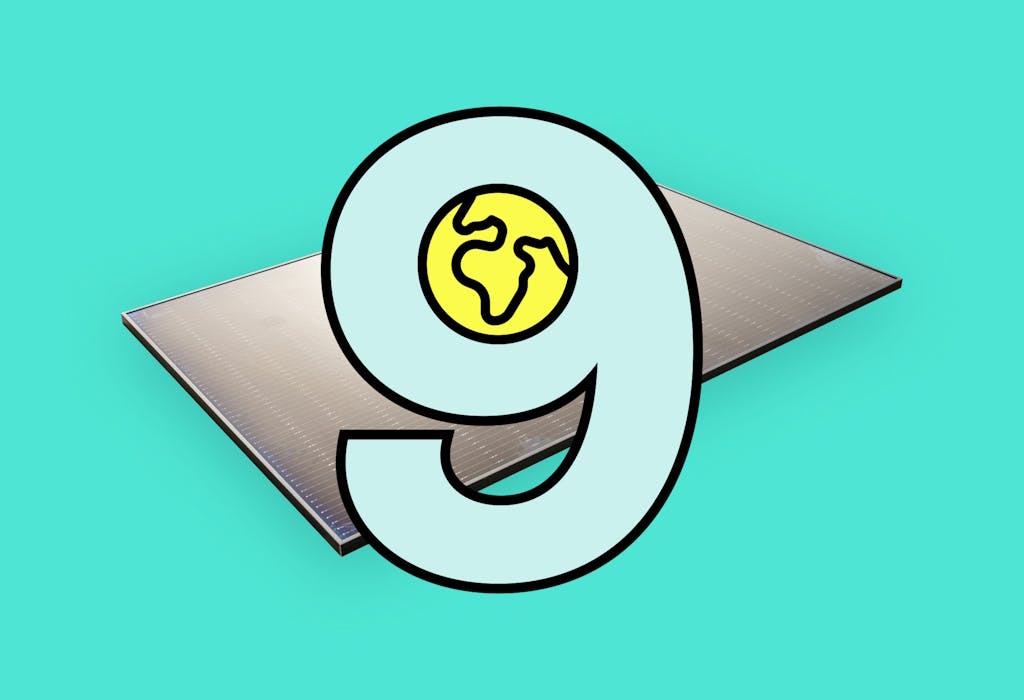- Solar advice hub
- Solar-technology
- The 11 most powerful solar panels
The 11 most powerful solar panels
Here are the most powerful, highest wattage solar panels currently available, with all the analysis you need to pick the best model for your home.


Why you can trust our content
We know that the solar industry is full of misinformation, but we only use reliable sources, including:
- Our experienced solar experts, installers and system designers
- Our own database of solar & battery system designs
- Authoritative bodies like MCS and the UK government




Calculate savings
What kind of home do you live in?
Calculate savings
What kind of home do you live in?
The most powerful solar panels: at a glance
The more electricity your solar panel system produces, the more money you can save on your energy bills – so it’s crucial to get a powerful system.
However, a high power rating is only one of the key attributes to look out for when you’re going solar. You should also consider a panel’s affordability, durability, and efficiency.
In this guide, we’ll explain why all of these factors should influence your decision, and count down the most powerful panels available to households at the moment.
If you’re wondering how much you could save with a powerful solar & battery system, enter a few details below and we’ll provide an estimate.
What are the most powerful solar panels?
The most powerful solar panel is AIKO's 795-watt (W) Neostar 2N+7, followed by Grand Sunergy's GSM-MH3/132-BHDG750 and RECOM's Lion RCM-750-8DBHM, which are both 750W.
We've got more detail about all 11 panels further down the page.
| Manufacturer | Name of panel | Power rating (W) | Watts / m² | Efficiency |
|---|---|---|---|---|
| AIKO | Neostar 2N+7 | 795 | 248 | 24.8% |
| Grand Sunergy | GSM-MH3/132-BHDG750 | 750 | 241 | 24.14% |
| RECOM | Lion RCM-750-8DBHM | 750 | 241 | 24.1% |
| Risen Energy | Hyper-ion Pro RSM132-8-720-745BHDG | 745 | 240 | 24% |
| Runergy | HY-DH132H10 | 740 | 238 | 23.8% |
| Talesun Solar | HYPRO TH8G66M | 735 | 237 | 23.7% |
| Astronergy | ASTRO N8 | 730 | 235 | 23.5% |
| Canadian Solar | TOPBiHiKu7 | 730 | 235 | 23.5% |
| Huasun | Himalaya G12 HS-210-B132 | 730 | 235 | 23.5% |
| Jolywood | JW Max JW-HD132N | 730 | 235 | 23.5% |
| Seraphim | Hydra | 730 | 235 | 23.5% |
Manufacturers measure their panels’ power levels by using standard test conditions (STC), a globally uniform environment used in solar labs across the world.
To achieve this state, scientists must keep the panel’s temperature at 25°C, expose it to a light source that’s precisely 1,000 watts (W) per m², and maintain the air mass at 1.5, which simulates the way sunlight travels to Earth.
Powerful panels are usually larger than the average model, but if you have the space and it makes sense financially, it could be worth it. After all, the more electricity your system generates, the more you’ll save on your energy bills.
There are other factors to consider though, including the panel’s price, durability, and warranties. The most powerful panel isn’t always the best option.
You can also find out more about our methodology further down the page – or click here to read it now.
11. Hydra, Seraphim
Power: 730W
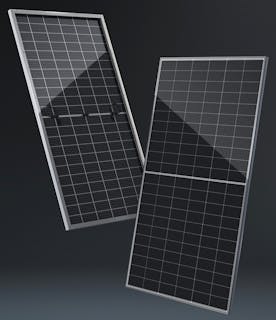
The solar panel with the best name on our list also has the joint-best performance warranty here.
Seraphim guarantees that its Hydra panels will function at 90.3% of their original efficiency after 30 years, which is around three percentage points more than most of the best warranties offer.
You can also get a 15-year product warranty with this panel, which is pretty standard in the industry.
And more than most solar manufacturers, Seraphim goes the extra step to making the world a better place. It's won awards for its socially responsible approach to solar, and has signed up to the UN Global Compact.
This voluntary scheme invites companies to commit to principles that encourage sustainability, human rights, worker rights, and anti-corruption efforts.
10. JW Max JW-HD132N, Jolywood
Power: 730W

Since receiving a large amount of investment in 2023, this company from east China has flourished.
This panel, from Jolywood's JW Max line, is the lightest on an admittedly heavy list, at 37.5kg – but it packs a punch.
730W and a 23.5% efficiency rating may seem low compared to the best of the best, but set against the rest of the market, they're top-tier attributes.
A 12-year product warranty is disappointing, but considering Jolywood claim that some of its other panels are resistant to hurricanes, snowstorms, and hail, you'd hope the JW-HD132N was also relatively durable.
9. Himalaya G12 HS-210-B132, Huasun
Power: 730W

Also sitting on 730W, we have Huasun's most powerful panel, with a name that starts off strong before descending into the standard dense string of letters and numbers.
This Chinese company is one of the largest heterojunction solar panel manufacturers in the world, with thousands of employees and 20 gigawatts (GW) of production capacity – more capacity than the UK currently has.
Huasun panels have been sold in more than 80 countries, according to the company, including this exceptional model.
As well as a 730W power rating, 23.5% efficiency score, and 15-year product warranty, the Himalaya G12 HS-210-B132 also comes with the joint-best heat resistance on the market.
For every degree over 25°C, it temporarily loses 0.24% of its efficiency, which is substantially less than most.
8. TOPBiHiKu7, Canadian Solar
Power: 730W
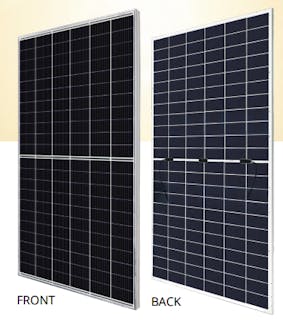
This is the only entry on our list to be designed in North America, even if the panel itself is manufactured in China.
And Canadian Solar represents its country well, by holding itself accountable.
The company produces an annual sustainability report that both publicises its good work – including how many homes it’s served and tonnes of CO2 it’s displaced – and also tracks the carbon footprint and payback period of its panels.
The TOPBiHiKu7 is also an excellent solar panel. It may lose 0.29% of its efficiency for every degree above 25°C – the joint-worst rating on this list – but that's still better than the industry average.
It’s also built for the cold. Like all top-tier models, it can withstand up to 5,400 Pascals of pressure from snow, but it can also deal with hailstones that are up to 3.5cm in diameter.
That's perhaps a little more relevant to northern Canada than the UK, but it doesn't hurt to be resilient.
7. ASTRO N8, Astronergy
Power: 730W

With its appropriately space-focused name, Astronergy is one of the oldest solar companies in China, dating back to 2006.
The bifacial ASTRO line has been its flagship product for years at this point, and the N8 is a clear improvement on the N7 2.0 – though only really in its wattage.
The 730W power rating is 80W higher, which is sizeable, but the N8 only holds this advantage because it's bigger.
At 23.5%, its efficiency is substantially lower than its predecessor's 24.1% rating, which makes it less of an upgrade and more a relative waste of space.
It's still a solidly top-tier panel, but the N8 follows the trend of manufacturers breaking power records by making panels bigger, instead of more efficient.
If you’re wondering how much you could save with a powerful solar & battery system, enter a few details below and we’ll provide an estimate.
6. HYPRO TH8G66M, Talesun Solar
Power: 735W

A small step up is Talesun Solar's HYPRO TH8G66M, with its 735W power rating and 23.7% efficiency ensuring it stays just above most of its rivals.
Its 15-year product warranty and top-tier performance warranty – Talesun promises 90.3% of the panel's original efficiency after 30 years – also speak to its slight superiority to what we've seen so far.
The HYPRO TH8G66M also holds the joint-best heat resistance in these rankings, and its junction box – which sits on the panel – has an IP68 rating, meaning it can endure being immersed in a metre of water.
Talesun Solar backs up its technological advances with charitable work, such as giving solar panels to rural schools in Thailand, and donating £300,000 to local communities in Hubei.
5. HY-DH132H10, Runergy
Power: 740W

Runergy was founded in 2013, but only started producing solar panels in 2022.
Since then, the company from China's eastern solar hub has gone from strength to strength, leading to the HY-DH132H10.
This panel is boringly named, but its 740W rating is enormous – and backed up by its 23.8% efficiency.
The manufacturer, which now has factories in China, the US, and Thailand, offers a 12-year product warranty, which is the only major drawback.
4. Hyper-ion Pro RSM132-8-720-745BHDG, Risen Energy
Power: 745W

The Hyper-ion Pro RSM132-8-720-745BHDG is a painfully extended name – the longest in this article – but its weight is more of a pressing concern.
At 40kg, it's around twice as heavy as the standard model, which could make some installers think twice.
However, it's otherwise impeccable, with its 745W power rating, 24% efficiency, 15-year product warranty, and a performance warranty that guarantees 90.3% of its initial efficiency after 30 years.
The panel even comes with the joint-best heat resistance around, just to round out its impressive datasheet.
3. Lion RCM-750-8DBHM, RECOM
Power: 750W

This impressive 750W panel comes with a 30-year product warranty – by far the best on this list.
And with a performance warranty that guarantees 90% of the panel's original efficiency at that 30-year mark, you should be set for decades to come.
It's also 24.1% efficient, and has the joint-highest heat resistance of any product here.
RECOM's factory is in Italy, making the Lion the only panel in this article made somewhere other than China.
2. GSM-MH3/132-BHDG750, Grand Sunergy
Power: 750W

This mish-mash of letters and numbers is a hair more efficient than RECOM's panel, 0.5kg lighter, and has an ever-so-slightly better performance warranty.
Otherwise, it's pretty much identical: a 750W panel that loses 0.24% of its efficiency with every degree over 25°C, looks like a standard, modern monocrystalline panel, and takes up 3.1m².
Unfortunately, Grand Sunergy only provides a 15-year product warranty. This falls short of the industry average, which according to our data is 19 years.
It's also a shame that the company from eastern China – whose product lines have names like Seapower and Desert, based on their intended locations – failed to give this panel a better name.
1. Neostar 2N+7, AIKO
Power: 795W

The Neostar 2N+7 is markedly more powerful than its closest competitors.
This 795W panel has a larger gap to second place (45W) than the difference between second and eleventh in these ratings (20W).
It's also one of the most efficient solar panels on the market, with a 24.8% rating that – again – puts it streets ahead of its powerful rivals.
At 3.2m², the Neostar is slightly larger than every other panel on this list, and its 15-year product warranty isn't particularly impressive – but these are small downsides.
AIKO is also helping the Austrian state of Burgenland reach its goal of becoming carbon neutral by 2030, by supplying the area with its technology.
This may seem minor, but it’s good to see a solar panel manufacturer actively fighting climate change.
What is W/m² and why does it matter?
It’s all very well getting powerful solar panels, but if you want to make the most of your roof space, you should maximise your watts per square metre, or W/m².
This is the power rating of a solar panel, divided by its size. The result can also easily be used to find the panel’s efficiency rating, as you can see above.
The average panel’s W/m² has climbed rapidly over the past few decades, though it seems to have hit somewhat of a limit since 2018, sticking at around 200W/m².
The best manufacturers have broken through this barrier, while others have chosen the easier path and just created bigger panels instead.
Always check that you’re getting the highest W/m² possible from your panels. If they’re nearly 4m², they may not be worth getting – even if their power rating is massive.
For more information, read our guide to how quickly solar panels are improving.
Our methodology
To create our rankings, we made a database of the best solar panels produced by the 21 largest domestic solar manufacturers.
We regularly update this bank of information with the newest solar panels, with all the details drawn from datasheets found on manufacturers’ sites and attached to their press releases.
As well as each panel’s power rating, we also note down its efficiency, performance and product warranties, watts per m², heat resistance, size, weight, and appearance, plus where the solar panel is made and its manufacturer’s green credentials.
Companies generally use the same technology in all their best products, so we’ve opted to only include a maximum of one panel from each manufacturer in our rankings.
What’s the most powerful type of solar panel?
The most powerful type of solar panel that’s available for residential usage is the monocrystalline panel.
These black solar panels make up the entirety of our list, and over recent years have become far and away the most popular type of solar panel in the world.
‘Tandem’ solar panels made of silicon and a synthetic material called perovskite, like the ones produced by UK manufacturer Oxford PV and Chinese company GCL, have the potential to one day overtake monocrystalline panels.
Trina Solar announced it had created a record-breaking 30.6% efficient panel in June 2025, with a 1.185m² frame that put its power rating at 360W.
This is obviously nowhere near enough for the panel to get onto our list, even if it was widely sold – but if Trina is able to increase its size to a pretty standard 2.4m² while maintaining its efficiency, it could top our rankings.
However, it could be a very long time before perovskite solar panels are available and affordable, with manufacturers currently trying to fix some significant longevity issues.
Has solar panel power increased?
Solar panel power ratings have increased massively over the past decade or so.
In 2010, the average solar panel would’ve been made with polycrystalline and capable of reaching 290W under standard test conditions, according to Wood Mackenzie.
These days, customers have a wide range of options above 500W, 600W, or even 700W – as shown by our list.
Every major domestic manufacturer sells panels with power ratings of at least 400W, and at least a dozen have released models that are 500W or higher.
A 3.46 kilowatt-peak (kWp) system installed at Germany’s Oldenburg University in 1976 – and still functioning today – is composed of 336 solar panels, each with a power rating of just 10.3W.
To create a similar system now, you’d usually need just five to eight panels.
Is power the most important solar panel factor?
Power is certainly among the most important solar panel factors, but it’s not the only one worth considering.
If a panel is powerful but massive, you may not be able to fit many of them on your roof – and therefore your system may end up producing less electricity than if you’d chosen a smaller model.
So it’s worth weighing a panel’s power rating against its size, as well as its durability and price, since going solar is a major, long-term investment.
The top panel here is just 65W more powerful than the bottom one, which is certainly a gap, but not one you should pay over the odds for – especially if you could get a better system by opting for a less powerful panel.
Solar panel affordability
The amount of solar electricity your panels produce plays a large part in determining your system’s break-even point, but so does the amount you pay in the first place.
The first step is being able to afford your system, but even after you’ve negotiated that hurdle, choosing more costly panels can extend your payback period by years if you pay upfront.
It’s not usually worth paying significantly more for gear that’s only slightly more powerful than cheaper versions – and as we’ve already pointed out, the difference in output among the best panels is minimal.
To learn more, check out our guide to solar panel costs.
Solar panel efficiency
Solar panel efficiency refers to the amount of naturally occurring light that your panels can turn into electricity.
Manufacturers refer to this attribute in percentage terms, so a solar panel that’s 20% efficient can convert 20% of the daylight it receives into electricity for your home or the grid.
You can also work out a panel’s efficiency by comparing its power rating with its size, or as it’s commonly known, watts per m².
The better your panel’s efficiency, the more you can fit on your roof, and the higher your output – and savings – should be.
You should always check how efficient a panel is, since a higher power rating is only a true positive if it comes without a large increase in size.
However, it’s also not worth overpaying for a small rise in your system’s efficiency. Most top-tier monocrystalline solar panels are extremely efficient, with little difference between them.
If a panel is more than 20% efficient, you should be set to make significant savings on your energy bills – and these days, most panels are.
Solar panel durability
Durability should be a crucial aspect of your buying decision, seeing as modern panels come with such a high upfront cost.
If your system functions well for its expected lifespan, you can recoup your costs – but if your panels often need to be repaired or even replaced, it could be costly.
Your payback period could grow, and in the worst cases the break-even point may disappear completely.
You should stick to monocrystalline panels, which are the most durable type of solar panel available to households right now – but no system is a sure bet.
That’s why you should think about signing up for Sunsave Plus, and taking advantage of the Sunsave Guarantee.
You’ll receive 24/7 monitoring, maintenance, plus a free battery upgrade - and a free inverter replacement, if required.
The Sunsave Guarantee also includes downtime protection – which means we'll credit your monthly payments if your panels underperform for an prolonged period of time – and your system will be insured by Aviva against damage, fire, and theft.
If you want to make any warranty claims, we’ll also manage those.
Next steps
Households can choose between lots of incredibly powerful solar panels at the moment – though there’s not much difference between them.
Even beneath the top tier of panels on this page, there are plenty of panels with high power ratings that may also come with more reasonable price tags.
As well as affordability, you should also balance a panel’s power rating against its size and durability. After all, there’s no use having a set of large panels that take up too much space or don’t last very long.
If you’re wondering how much you could save by getting a powerful solar & battery system, just answer a few quick questions, and we’ll provide an estimate.
Most powerful solar panels: FAQs
Related articles

Written byJosh Jackman
Josh has written about the rapid rise of home solar for the past six years. His data-driven work has been featured in United Nations and World Health Organisation documents, as well as publications including The Eco Experts, Financial Times, The Independent, The Telegraph, The Times, and The Sun. Josh has also been interviewed as a renewables expert on BBC One’s Rip-Off Britain, ITV1’s Tonight show, and BBC Radio 4 and 5.
